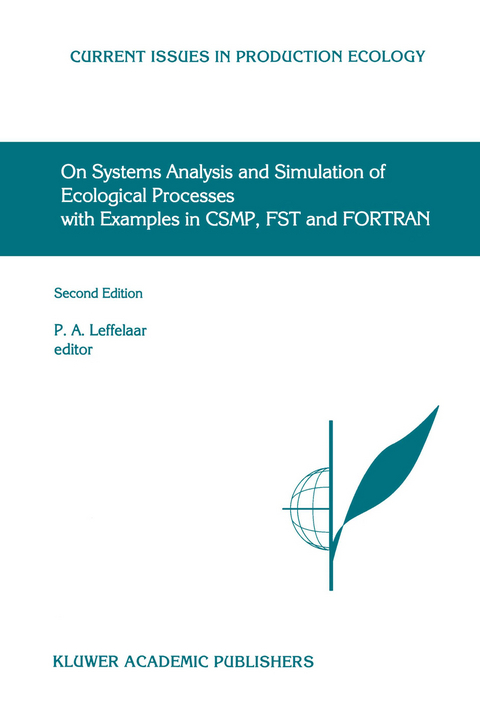
On Systems Analysis and Simulation of Ecological Processes with Examples in CSMP, FST and FORTRAN
Seiten
1998
|
2nd ed. 1999
Springer (Verlag)
978-0-7923-5525-0 (ISBN)
Springer (Verlag)
978-0-7923-5525-0 (ISBN)
Presenting a method for the analysis of ecological systems using numerical models, this book describes the development of these models by means of relational diagrams and rate equations. The calculation of the dynamic behaviour of the models is studied through small computer programs.
Systems approaches are excellent in integrating insights in the physical, chemical, Systemsapproachesareexcellentinintegratinginsightsinthephysical,chemical, physiological and ecological processes that dictate the behaviour of living systems, of physiologicalandecologicalprocessesthatdictatethebehaviouroflivingsystems,of which which agro-ecosystems agro-ecosystems are are important importantones. ones. Furthermore, Furthermore, they theyhelp help to tobridge bridge the the gap gap between betweendetailed detailed process processoriented oriented studies studies and and higher higherintegration integration levels. levels.
Systems Systems approaches approaches are are roughly roughlycategorized categorized in inthree three groups groups of of studies: studies: (i) (i) predictive predictive studies studies to to support support decision decision making making and and guide guide interventions, interventions, (ii) (ii) systems systemsanalysis analysis and and simulation simulation in inorder order to toget get insight insight and and understanding understandingof of the the functioning functioningof of (living) (living) systems, systems, and and (iii) (iii) explorative explorative studies studies to to investigate investigate possible possible options options for for development development and and trade trade offs offs of of aims, aims,objectives objectives and andconstraints. constraints. All All these these systems systems approaches approaches are are now nowwidely widely used used in inecological ecological systems systems including including agriculture, agriculture, and and applied appliedin in land landuse use planning. planning.
This This book book is is an an introduction introduction to toone one of ofthe the major majorfields: fields: systems systems analysis analysis and and simula- simula- tion. tion.
Systems approaches are excellent in integrating insights in the physical, chemical, Systemsapproachesareexcellentinintegratinginsightsinthephysical,chemical, physiological and ecological processes that dictate the behaviour of living systems, of physiologicalandecologicalprocessesthatdictatethebehaviouroflivingsystems,of which which agro-ecosystems agro-ecosystems are are important importantones. ones. Furthermore, Furthermore, they theyhelp help to tobridge bridge the the gap gap between betweendetailed detailed process processoriented oriented studies studies and and higher higherintegration integration levels. levels.
Systems Systems approaches approaches are are roughly roughlycategorized categorized in inthree three groups groups of of studies: studies: (i) (i) predictive predictive studies studies to to support support decision decision making making and and guide guide interventions, interventions, (ii) (ii) systems systemsanalysis analysis and and simulation simulation in inorder order to toget get insight insight and and understanding understandingof of the the functioning functioningof of (living) (living) systems, systems, and and (iii) (iii) explorative explorative studies studies to to investigate investigate possible possible options options for for development development and and trade trade offs offs of of aims, aims,objectives objectives and andconstraints. constraints. All All these these systems systems approaches approaches are are now nowwidely widely used used in inecological ecological systems systems including including agriculture, agriculture, and and applied appliedin in land landuse use planning. planning.
This This book book is is an an introduction introduction to toone one of ofthe the major majorfields: fields: systems systems analysis analysis and and simula- simula- tion. tion.
A Fundamentals of dynamic simulation.- 1 Philosophy and terminology.- 2 Basic elements of dynamic simulation.- 3 A simulation language: Continuous System Modeling Program III.- 4 The growth of yeast.- 5 Additional exercises I.- B Advanced themes in dynamic simulation.- 6 Numerical integration and error analysis.- 7 Aspects of structured programming using CSMP and FORTRAN.- 8 Modelling of ageing, development, delays and dispersion.- 9 Mass flow, numerical dispersion and diffusion.- 10 Simulation using a general purpose computer language.- 11 Additional exercises II.- References.
| Reihe/Serie | Current Issues in Production Ecology ; 4 |
|---|---|
| Zusatzinfo | XIII, 319 p. |
| Verlagsort | Dordrecht |
| Sprache | englisch |
| Maße | 155 x 235 mm |
| Themenwelt | Informatik ► Grafik / Design ► Digitale Bildverarbeitung |
| Mathematik / Informatik ► Informatik ► Theorie / Studium | |
| Mathematik / Informatik ► Mathematik | |
| Naturwissenschaften ► Biologie ► Ökologie / Naturschutz | |
| ISBN-10 | 0-7923-5525-3 / 0792355253 |
| ISBN-13 | 978-0-7923-5525-0 / 9780792355250 |
| Zustand | Neuware |
| Haben Sie eine Frage zum Produkt? |
Mehr entdecken
aus dem Bereich
aus dem Bereich
Modelle für 3D-Druck und CNC entwerfen
Buch | Softcover (2022)
dpunkt (Verlag)
34,90 €
alles zum Drucken, Scannen, Modellieren
Buch | Softcover (2024)
Markt + Technik Verlag
24,95 €


